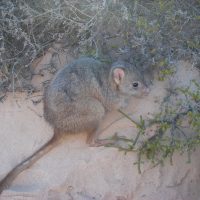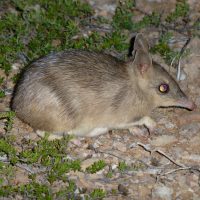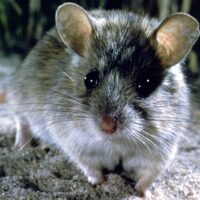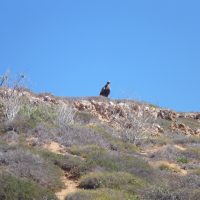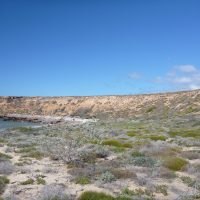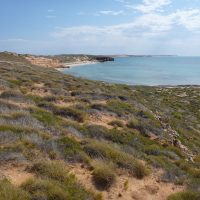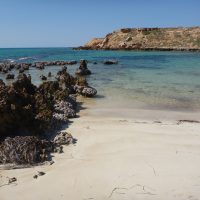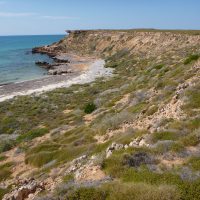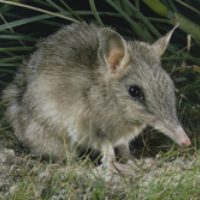Bernier & Dorre Islands Nature Reserve
These islands west of Carnarvon are home to some of the rarest wildlife in the world and are ‘A’ Class nature reserves.
The value of Bernier and Dorre Islands Nature Reserve to world biodiversity contributed to Shark Bay’s inclusion on the World Heritage List as they are the last bastion for five critically endangered land mammals, four of which occur naturally in the wild nowhere else – the Shark Bay mouse, Shark Bay bandicoot, banded hare-wallaby, and rufous hare-wallaby. Populations of the boodie (burrowing bettong) occur elsewhere but the survival of this species depends on conservation intervention.
Access to Dorre Island is prohibited for quarantine purposes. It is the only natural population of Shark Bay bandicoot free of a papilloma virus.
To reduce potential wildfire, weed, pest and disease risks to Bernier Island, camping is not permitted. Fires are also prohibited on the island.
Rising sea levels and some 8 000 years ago left Bernier and Dorre Islands separated from the mainland and inaccessible for Aboriginal occupation.
In 1696 William de Vlamingh surveyed and named Dorre Island from the Dutch words ‘Dor’ meaning dry or barren and ‘Eyland’, meaning island. William Dampier’s expedition to Shark Bay in 1699 included a brief account of Dorre Island’s natural history and a collection of botanical samples.
The islands were not visited again until 1801 when the French scientific expedition on the Geographe named Bernier Island after the expedition’s astronomer, Pierre Francois Bernier. The French noted the islands to be desolate, inhospitable and lacking in water. Explorer George Grey also encountered hardships in 1839 when his attempts to establish a permanent depot on Bernier Island failed.
In 1860, the pioneer Julius Brockman camped on Dorre Island and his diary gives a graphic account of fire on the island – ”The island was high with spinifex, which had never been burnt …. There were thousands of wallaby. The wind was blowing a gale from the south and when I lighted a fire to camp, it swept the island bare for twenty two miles.” Later he noted “I walked about the island, which was now bare as a sand patch and what were not burnt of the animals would have no food except seaweed until rain fell again.”
Further devastating fires were reported on Dorre Island in 1908 and 1973 and the widespread destruction led to concerns for the survival of the island’s banded hare-wallabies.
The islands were leased for pastoral use in 1864 but it was not until the turn of the century that Mr G Baston grazed sheep on Bernier Island. He built a house but his pastoral attempt was eventually abandoned. Further grazing leases were granted but never put into practice.
Sandalwood cutters operated on Bernier Island in 1896 and, the same year, JT Tunney from the WA Museum studied and took specimens of the island’s mammals.
In 1907, the Western Australian government established the Lock Hospitals on the islands for the segregation and cure of Aborigines suffering from diseases. Patients were brought from all over the Northwest with females occupying the hospital on Bernier Island (Mr Baston’s old homestead) and males accommodating the hospital at White Beach on Dorre Island.
A government report noted that “The patients are allowed to live in their own natural way as far as possible, game is at present plentiful and hunting and fishing are the principal occupations of those who are fit to do it”.
Noted anthropologist Daisy Bates described the hospitals in 1910:”There is not, among all my sad sojourn amongst the last sad people of the primitive Australian race, a memory one-half so tragic and harrowing, or a name that conjures up such a deplorable picture of misery and horror unalleviated, as these two grim and barren islands off the West Australian coast that for a period, mercifully brief, were the tombs of the living dead”.
By 1918 the Lock Hospitals were closed and the few remaining patients moved to hospitals on the mainland. Over nine years of operation more than 700 Aborigines were admitted to the Lock Hospitals. At least 162 died on the islands.
Conservation values of Bernier and Dorre Islands were recognised as early as 1907 when the Natural History Society of Western Australia requested that the islands be set apart as reserves for flora and fauna. This proposal was not agreed to by Cabinet. Three later requests to the Lands Department for prohibiting cats and firearms to protect the island’s native fauna were also denied.
Goats left on Bernier Island from the pastoral and Lock Hospital eras flourished and by the 1950’s had devastated the island’s vegetation. A 20 year goat eradication program eventually removed the goats but they had already caused severe soil erosion and created extensive mobile sand dunes.
Bernier and Dorre Islands were finally gazetted ‘A’ class nature reserves for the conservation of fauna in 1957.
Four of the five species of endangered mammals on Bernier and Dorre occur nowhere else, yet less than 100 years ago mainland Australia supported widespread populations of all five species.
Please help protect wildlife on these islands:
- Please do not land on Dorre Island
- Download the Island Protection brochure before you go to help you prepare for a trip.
- Ensure boots, clothing and anything you take onto Bernier Island are clean and free of seeds, insects, mice and other hitchhikers
- Do not light fires, collect firewood from the island or bring firewood to the islands
- Do not camp
- Do not take pets or firearms onto the island
- Do not leave any food, rubbish or bodily waste on the island
Research on Bernier and Dorre islands provides insight into the continuing evolution of species through the effects of isolation. Separated from the mainland when sea levels rose about 10,000–8,000 years ago, some island species have evolved into distinct subspecies of their extinct mainland relatives, the banded hare-wallaby is an example of this.
Other island species have developed interesting physical and behavioural variations. For example:
- Rufous hare-wallabies on Bernier and Dorre Islands are larger than their captive-bred counterparts in the Tanami region of central Australia.
- Unlike boodies on Barrow and Boodie Islands, boodies on Bernier and Dorre islands are known to live alone rather than in extended warrens housing many animals.
- The Shark Bay mouse does not appear to use burrows as much as most other Pseudomys
Bernier and Dorre islands have been largely spared the disturbances on mainland Australia. They provide a snapshot of ecosystem function prior to European settlement and demonstrate the value of feral-free habitats for native wildlife. Research into the ecology of the islands’ mammals is instrumental in developing recovery plans for these species elsewhere:
- Much has been learned about species population, diet, home ranges, reproduction rates and nest sites.
- Knowledge gained from these studies has resulted in successful captive-breeding programs for the Shark Bay bandicoot, banded hare-wallaby, boodie and Shark Bay mouse.
- Understanding of the animals’ requirements has helped with their successful introduction to new sites, establishing breeding populations to help secure the long-term survival of the species.



